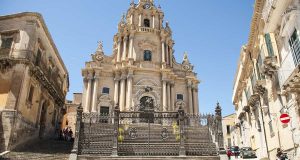Palazzo Cosentini (Cosentini Palace) is one of the most beautiful baroque villas in Ragusa. Its balconies, varied and rich in details, are the most characteristic among those of the city. The villa is one of the monuments in Ragusa that are part of the UNESCO serial site: Late Baroque Towns of the Val di Noto.
The history of Palazzo Cosentini
Palazzo Cosentini in Ragusa was built at the end of the 18th century by Baron Raffaele Cosentini and his son Giuseppe. The building is located at the intersection of two important streets of the ancient city. The first is the Salita Commendatore, the flight of steps that was once the only link between the upper and lower parts of Ragusa. The second was the street of San Rocco, which, passing in front of the church of the same name, then connected to the roads leading to Comiso and Chiaramonte Gulfi. For this reason, in the two corners of the main elevation, there were statues of the patron saints of travelers. One was dedicated to St. Francis of Paola and is still visible, while the other, which has been lost, represented St. Christopher or St. Rocco.
Architecture of the palace
Palazzo Cosentini has an irregular rectangular plan and is divided into three different levels. The elevations of the palace are characterized by pilasters ending in composite capitals, elegant windows rich in decorations and friezes, and splendid balconies. The large main door, located in Via Commendatore, is preceded by four steps and is decorated by two high columns set into the wall and slightly protruding. Above the main door is the first of the four artistic balconies of this splendid Baroque villa. In ancient times, the palace was connected to the nearby church of Santa Maria dell’Itria, where the Cosentini family had the Chapel of the Crucifix built, by stairs and internal roads.
The balconies of Palazzo Cosentini
The most characteristic element of Palazzo Cosentini are certainly its balconies. As in other splendid baroque palaces of eastern Sicily, such as Palazzo Bertini in Ragusa, Palazzo Nicolaci in Noto, Palazzo Beneventano in Scicli or Palazzo Napolino in Modica, the typical grotesque masks are also present here. The balcony of the Salita Commendatore is known as the “balcony of slander”. Five human-like masks hold symbolic animals such as the snake and the scorpion in their mouths. Their hideous appearance contrasts with that of the five friendly-looking female figures above them. Arriving in Mazzini Street, three more balconies can be seen. In the first, also known as the “Storyteller’s Balcony”, there is a figure in the middle holding a scroll. Perhaps this is the script he is about to recite, accompanied by the figures on either side of him holding various musical instruments. The second is the “Balcony of Wealth”, in fact there are female figures represented with symbols of abundance such as fruit and cornucopia. The last one is the so-called “Gentleman’s Balcony”. You can see an innkeeper with a barrel, a flute player and a female figure offering her favors to the noble gentleman. She is depicted with a common appearance and could possibly represent a member of the Cosentini family.
Aggiungi ai preferiti






























